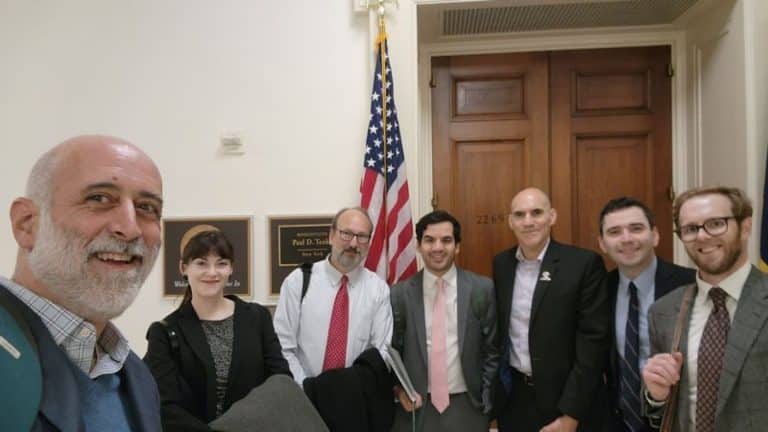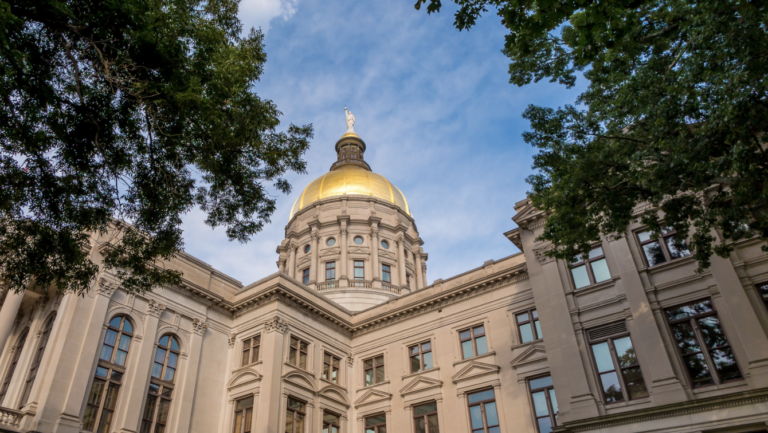This blog post was written by Brady Watson, former Civic Engagement Coordinator for the Southern Alliance for Clean Energy.
Knoxville Mayor Indya Kincannon is convening a newly-formed city Climate Council in a series of meetings to help create a plan for meeting carbon reduction goals adopted by City Council. The Council first met in May 2020, again on August 11, and most recently on September 8. Meetings will continue meeting through this fall and winter. You can find an overview of the Council in our previous blog post here, and more information in our webinar recording here. To learn more about the Mayor’s climate council and see the schedule of meetings, visit the City of Knoxville’s website. Below, we share updates from the Climate Council meetings on September 8.
Climate Council Meeting on Sept. 8, 2020
The Knoxville Climate Council met again on Tuesday, September 8th to discuss energy and buildings. For the first time, some members of the council met in person at the City County building. You can watch a recording of the meeting here and read a recap of the Council’s August 11 meeting here.
The meeting once again kicked off with an update from Erin Rose on the Equity Working Group, which had met to discuss the 9 transportation strategies presented by Erin Gill during the August Transportation Working Group meeting. Erin explained that the group was still in the process of shaping equity evaluation criteria, and now could begin focusing on community engagement to gather feedback on the various strategies. She mentioned that the group would need to figure out how to justify proposed strategies, and how to work through the barriers presented by the COVID-19 pandemic.
Survey Results Show Emphasis on Weatherization and Energy Efficiency
Next, City of Knoxville Sustainability Director Brian Blackmon gave an update from the Transportation Working Group and once again went over the surveys completed by that group. He also indicated that a more in-depth follow-up survey was sent asking for further ranking of transportation strategies based on the discussions held during the last meeting. There will be a follow-up call held to debrief those findings amongst the Transportation Working Group members.
Blackmon then began the discussion on energy and buildings by presenting the results from the baseline survey rankings from these strategies. You can see a breakdown of the proposed strategies below. Of particular note with these rankings was the higher prevalence of strategies being rated as “not important” as compared to the transportation survey results. It was noted that these “not important” votes were likely driven by a view that they could potentially disincentivize development. Members of the energy and buildings technical subcommittee also placed a higher value on market incentives that would encourage weatherization and efficiency investments that exceed building code requirements first, with investments in renewables coming next.
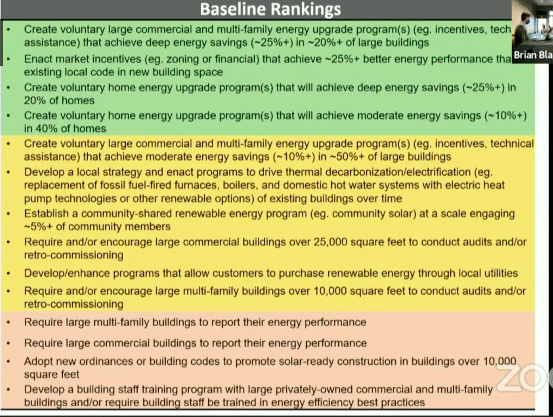
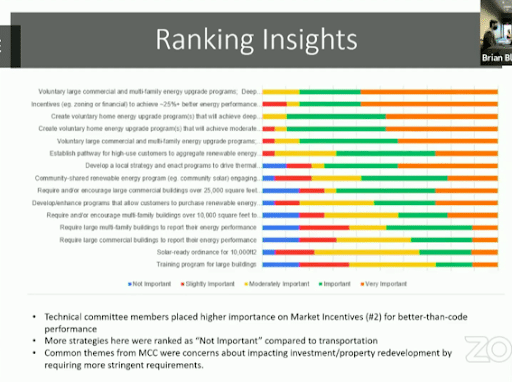
Investments In Solar and Efficiency Can Save Cities Money in Long Run
The group then shifted to hearing presentations from the technical panelists, beginning with Steve Seifried from AMERESCO, a leading energy as a service company. Seifried began his presentation with the old adage “the best time to plant a tree is 20 years ago, the next best time is now.” The image below provides a bit of context on AMERESCO and its ongoing partnership with the City of Knoxville, which includes energy management and efficiency improvements, solar installations, and other support that has resulted in over $12MM in savings for the city.
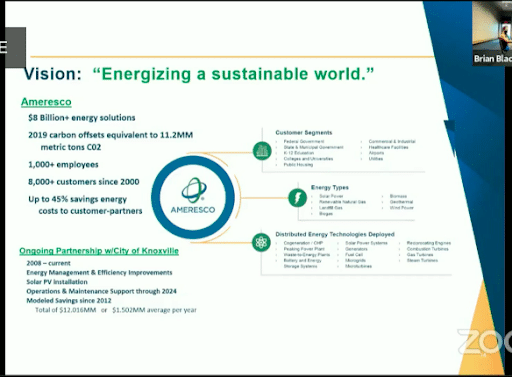
Seifried continued by pointing out that the bottom line for many stakeholders is that energy creation and energy savings can lead to avoided costs for Cities and residents alike. He also mentioned some relatively new trends in the sector which have led to more distributed energy resources from sources such as solar, rather than centralized energy sources that have typically been fossil fuel based, and pointed out the value of solar and battery storage, including avoided costs for Solar PV, lower capital and capacity investments into assets and infrastructure, and targeted environmental benefits. Part of the task for the Climate Council will be to determine what investments should be made now, rather than 10 or 20 years from now.

Gil Hough from the Tennessee Solar Energy Industries Association continued the panel presentations with some specific insight into the solar industry. As shown in the chart below, as the price for installing solar has continued to decrease, deployment has gone up significantly in the last 10 years. TVA has 1,500 MW of solar operating or under contract currently.

The next image shows regional solar investments throughout the Southeast as of 2019. As you can see, Tennessee ranks ahead of a few of our peer states on 2019 investments, but falls far short of our neighbors in North Carolina and Georgia in both 2019 investments and overall solar installed, which is something SACE recently explored in our third annual “Solar in the Southeast Report.” As you can also see, the states that have invested in more solar have also seen much more economic opportunity. 
The Knoxville Utilities Board (KUB) is currently exploring a time-of-use (TOU) rate pilot program, which would base the price customers pay for energy on the utility’s cost to meet demand over that specific time period, typically with higher prices during times when demand for electricity is higher, and correspondingly lower prices when demand for electricity is lower. TVA has also offered local power companies (LPCs) like KUB a “flexibility” clause which allows them to self-generate up to 5% of their load. The problem with this is that the way TVA calculates 5% actually results in LPCs not being able to generate the full 5% from renewable energy sources. For more information, please check out our recent blog on this topic. (Note that after initial publication of this blog, TVA changed the formula for how they calculate the 5%, which slightly increased the amount of self-generation possible for LPCs).
Hough also pointed out a few things that are missing from the KUB system, including a simple way for residential and small commercial businesses to sell power into the KUB distribution system at a fair price. In his view, the ideal program would:
- Let customers take advantage of the federal Investment Tax Credit (ITC)
- Encourage customers to participate in the new TVA Green Connect solar installer quality program
- Help customers qualify for the State of Tennessee as a Certified Green Energy Production Facility
For readers who would like to learn solar in the Tennessee Valley, TenneSEIA is hosting a webinar on October 7th. You can see the agenda and sign up here.
Building Design Has Important Role to Play
The next presentation was given by Michael Davis with the American Institute of Architects East Tennessee chapter. As Davis pointed out, roughly 40% of carbon emissions are associated with buildings, granting architects the ability to lead on this issue. Historically, according to Davis, energy efficiency has not been a part of building design from the beginning, so it is often seen as an expensive addition later on in a project. By incorporating energy efficiency earlier on in the process, the costs go down, and adoption is likely to go up. And, according to AIA, design strategies that focus more on energy efficiency can account for about 50% of fossil fuel energy reduction in new buildings. In fact, AIA has made a commitment to make operations in all new buildings carbon neutral by 2030. 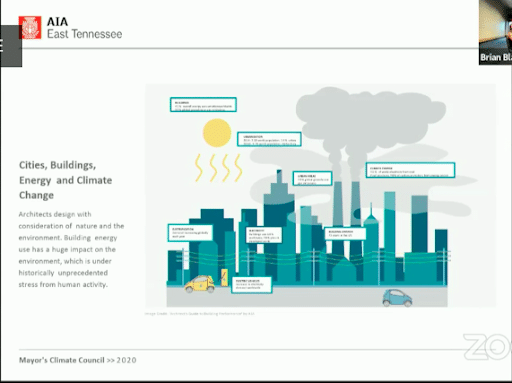
The Climate Council then heard from Dr. Joshua New of Oak Ridge National Lab (ORNL). He began by reiterating that the fact that roughly 40% of U.S. energy emissions come from the building sector resulted in $412 billion in energy bills for U.S. customers in 2019. He further broke down the usage between residential and commercial: explaining that in the U.S., residential buildings make up 96% of the number of buildings and use 54% of the building-related energy, while commercial buildings make up 4% of the number of buildings, but use 46% of the building-related energy.

He continued by explaining that climate change will result in climate zones moving north in the United States, and that builders, utility companies, and members of the Climate Council will have to consider this in their planning processes.
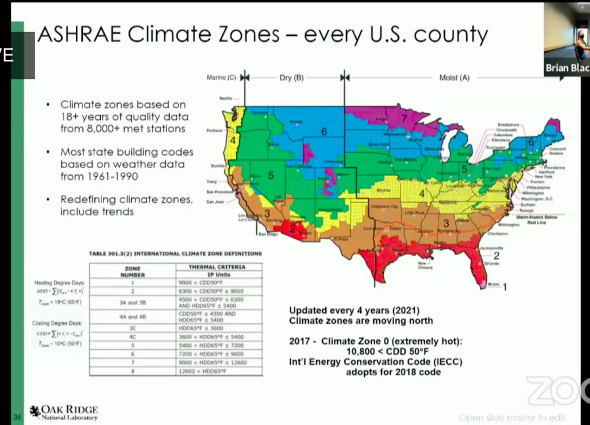
ORNL has also laid out a 5 year vision to create a “digital twin” of every US building using the following methodology:
- Quantitatively rank most important building inputs
- Time on world’s #1 fastest high-performance supercomputers
- Identify and compare data sources for important inputs
- Establish partnerships and application program interfaces for scalable data retrieval
- Algorithms to extract building properties
- Create OpenStudio and EnergyPlus models
- Make models freely available
These models can then be used by cities and utilities to benchmark, reduce, and then offset their energy and emissions. Recent examples of this include the digital mapping of the University of Tennessee Knoxville campus and the entire Electric Power Board service territory in the City of Chattanooga. The results for the latter project are available at http://bit.ly/virtual_epb. The nationwide energy study is expected to be completed by the end of the year, and the models and energy use simulators are expected to be ready for free public use by the first quarter of 2021.
Still Working Toward Consensus
City of Knoxville Chief Policy Officer Erin Gill brought up the lack of consensus on some of the energy and building strategies. Steve Seifried said the value proposition of solar is a matter of perspective and debate amongst utility providers. There is agreement on the cost to install solar and that solar leads to lower distribution expenses and creates and retains jobs. However, the valuation of the environmental benefits of solar, according to Seifried, is more challenging.
Erin Rose asked Dr. New if he could frame his work in the frame of energy savings and low-income housing stock. He indicated that that was not happening too often that he could speak of, and that at the Department of Energy level there is a lot of discussions, but not investment or decision making. In addition, he said that much of the work being done in the private sector is not shared, and that was one reason they wanted to share their energy modeling data, including the recently completed study for EPB.
SACE’s own Maggie Shober then asked about funding for the EPB study and what was being done with the data currently. Dr. New indicated that the project had been funded over the past 3 years, costing over $1 million, with funds coming from the city and EPB. He said the project would wrap up at the end of September, and that EPB was using it for program formulation. Shober followed up by asking how ORNL measured emissions reductions, to which Dr. New responded that they used the EPA database with regional information. The discussion then turned to how the emissions intensity of electricity changes throughout the day and year depending on what power plants are running.
The “Duck Curve”
Some stakeholders present argued that the “duck curve” poses a challenge for TVA. The “duck curve” is a situation sometimes experienced in parts of California and elsewhere that have high penetrations of solar generation coupled with high evening electricity load, so that solar brings down the daytime peak but the system experiences a high ramp rate (i.e. sharp increase in load) as the sun sets. Both Hough and Shober agreed that the “duck curve” is not currently – and will not be – an issue in Tennessee because the state has such low levels of solar installed.
Final Takeaways
Finally, the conversation shifted to general reaction to the survey rankings of proposed strategies. George Wallace of Coldwell Banker Realty suggested that building incentives are the most important to change behavior around building and energy efficiency/renewable energy investments.
Maggie Shober from SACE said that most of the strategies would need to be implemented as a matter of prioritization and weighing old buildings versus new buildings. “The need is to decarbonize quickly and we can’t get there if we only do new buildings,” she said. She also mentioned that KUB should not be incentivizing new natural gas service, which they do currently.
Stan Johnson from Socially Equal Energy Efficient Development (SEEED) asked about how incentives could be used in a manner that would carry over to the next owner of a particular property, and increase appraisal value so the investments in things like energy efficiency would have a return and thus be more appealing to building owners. As an example, Johnson said, “A granite table top equals $5,000 in added appraisal value, but $5,000 in insulation doesn’t make that much more value.”
Wallace indicated that “if you lower building expenses… that raises profit, and the value of the building.” He also said that “Single-family housing investments are higher but not seeing those sell faster or at a better price. The market is not quite there, but I think it will get there. Right now, if you invest 20% on cost-saving measures, you are not going to get that back.” It is not clear whether he was talking about only new buildings or about both new buildings and retrofits of existing buildings.
Shober then raised the issue of how you incentivize. “There are traditional incentives like rebates on a new HVAC system or heat pump, and then there are things like on-bill financing, where the cost of putting in a new HVAC goes with the KUB bill or with the house address. These investments can help ease energy burdens, improve indoor air quality, and reduce greenhouse gas emissions all at the same time.”
Erin Rose mentioned that TVA’s home uplift weatherization program doesn’t operate by a savings-to-investment ratio, which is pretty unheard of. “The reason from TVA is because it falls within their mission that housing quality and energy is affordable.” However, she stated, “Energy burdens are high in the Southeast. A third of people going into that program find it extremely difficult to pay their bills, sometimes choosing between heating, food, and medications. If these strategies don’t address some of these needs because of energy burdens or lack of access to weatherization where the waiting list in Knoxville is 2,000-3,000 people long, we will continue to have big problems.”
Stan Johnson continued by saying “These small programs don’t address the issue in a large enough concept. We need to be thinking about 20 years in the future. I love what KUB and TVA are doing (with Home Energy Uplift), but are we really talking about the same stuff? If there are only 2,000 people on a waiting list but the problem is really more like 10,000 people, then we’re talking about $100 million to address the problem. Knoxville Extreme Energy Makeover (KEEM) was just 1,300 residents and we still have 2,000 on the waiting list.” If we continue at the current rate and weatherize 100 homes per year it will take 20 years just to get through the current waiting list.
Shober once again chimed in saying, “Home energy uplift is a good start, but it’s pennies on the dollar, and only open to single-family, owner-occupied homes, with a huge waiting list. We also need to do more as small businesses struggle with energy burdens too.”
No Wiggle Room for Tax Increases
When asked about wiggle room for tax increases to pay for incentives, Mayor Kincannon responded “no.” Navigating these tough economic challenges will be an important task for members of the Climate Council.
SACE will continue to engage in this work as part of the Climate Council with community partners. The next convening of the Mayor’s Climate Council will occur in October with the energy and building technical working group. Watch for a follow-up from us summarizing the outcomes of that and future meetings.
#KnoxvilleClimateCouncil

